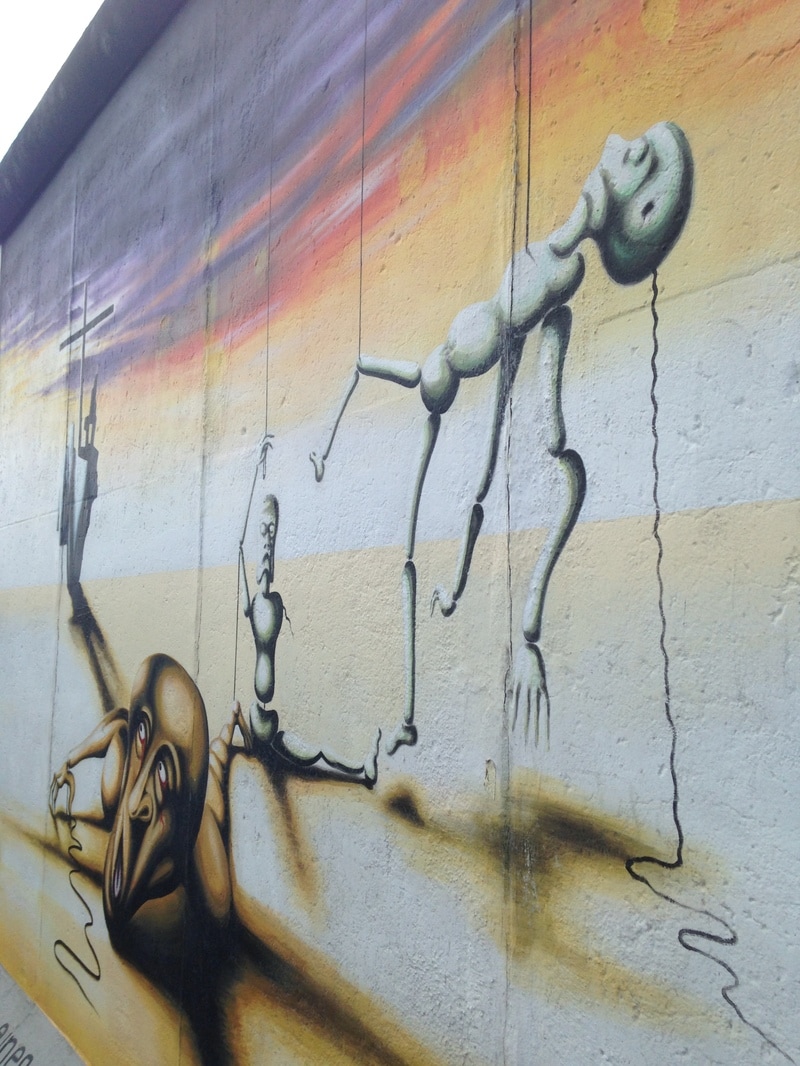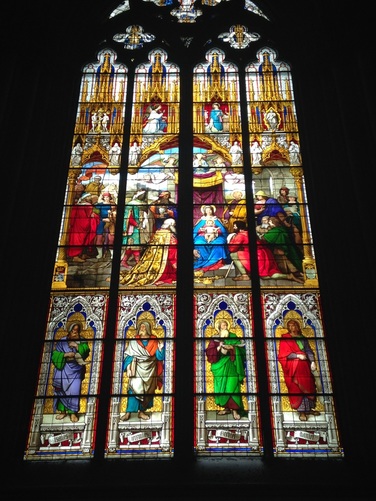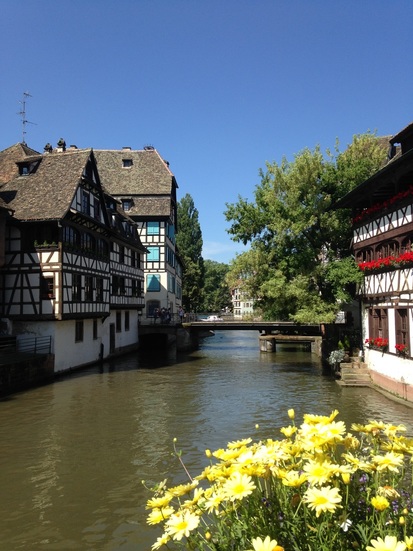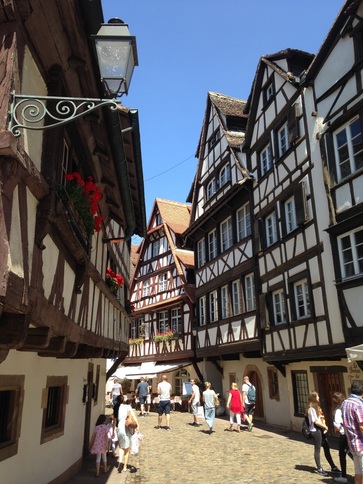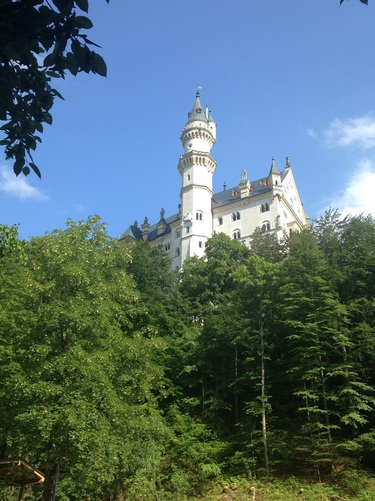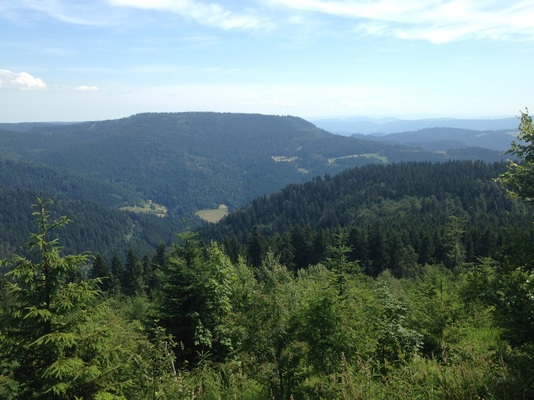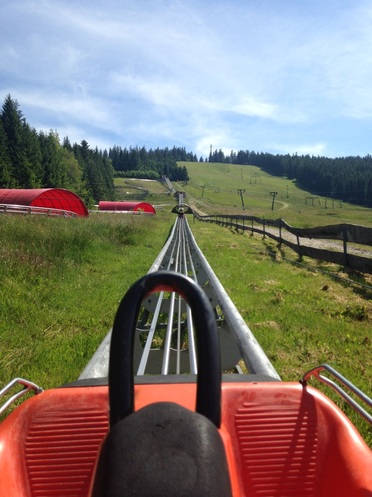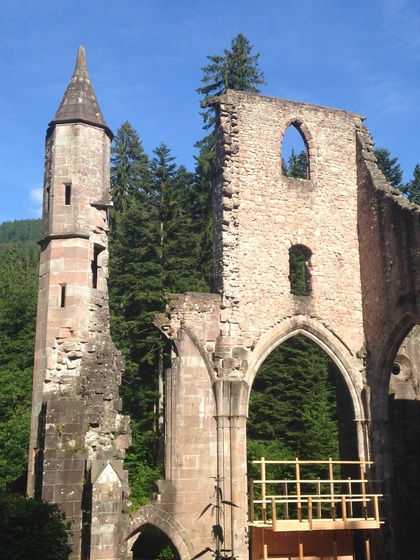|
You know those word association games? The ones where you hear a noun and say the first word that comes to mind? Like Peanut, allergy. Or Christmas, tree. Or Haughty, cat. Stuff like that? For me, when I hear the word Berlin, the first association that pops to mind is: WALL. As an amateur history enthusiast, the Berlin Wall holds a special degree of significance as an iconic symbol of Col-War divisiveness. I first read about the Berlin Wall in our family’s World Book Encyclopedia after the events of 9/11. Dad was struggling to impress upon my befuddled middle-school brain just how significant the collapse of the WTC towers was as we watched endless footage on CBC in the basement. He compared the terrorist attacks to the dismantling of the Berlin Wall and the ensuing reunification of Germany. It was a moment that would forever change the world and he claimed that sometimes “you’ll go to sleep and find the world is different than when you awoke.[1]” He claimed that I’d always recall the moment I first heard of the 9/11 attacks in the same way that his generation reminisced about where they were “when The Wall fell.” When I learned that we were spending a weekend in Berlin, I instantly became excited to see the colourful remnants of the wall that had played such a vital part in modern European history. Although other sights like the Reichstag, Holocaust Memorial and the Brandenburg Gate were appealing, most of my enthusiasm was channeled to visiting the East Side Gallery, the longest remaining stretch of wall covered with refurbished street art from the 1980’s. As we trooped through Berlin, reminders of the wall were everywhere. Bricked lines in the street followed the haphazard outline of the partition and served as a memorial of the partition. Spray-painted chunks of the wall were sold in tourist shops alongside postcards and books emblazoned with black-and-white photographs of the militarized zone and Checkpoint Charlie.[2] It seemed clear that memory of the wall was still fresh in the minds Berlin’s people and the tourists who visit. As we arrived at the East Side Gallery, the wall, from a distance was underwhelming. It looked exactly like what I suppose it really is: a bald concrete wall plastered with graffiti scribbles in a weathered part town. As I got closer though, I began to recognize some of the restored murals and my long-lived appreciation for street-art and history took over. There was “The Kiss”, the blue Volkswagen and half a dozen other pieces I recognized from pictures of the wall in the nineties from my frenzied encyclopaedia-research after Dad’s post-9/11 explanatory talk. As we strolled the length of the gallery admiring the politically-charged artwork, I couldn’t help but ponder the torturous consequences that this wall had for the thousands of families and friends it divided. I remembered a short documentary I’d watched in high-school about the tragic story of Peter Fechter, an eighteen-year-old bricklayer who was shot and killed as he tried to escape East Germany. The East Side Gallery was both a sobering reminder about the costs of totalitarian ideologies and a testament to the power of art to combat them. I realized I wanted a piece of it. At the very, very last minute before leaving Berlin, I admitted that a piece of the Berlin Wall was required for my blossoming collection of random statuettes and mementos on my shelf in Paraguay. I knew it was cheesy. I doubted that the spray-painted concrete chunks on display in the stores were genuine.[3] But the possibility of owning a piece of the Berlin Wall was tantalizing for reasons I still can’t quite explain. After a frantic 10:00PM search for shops that were still open, I purchased a small chunk of concrete for twenty euros. I can hear my sister’s mocking laughter now… My chunk of concrete is currently siting on my wooden bookshelf boasting its origin with the etching Berliner Mauer in its glass pedestal. It is interesting how, of all the things we did in Berlin, visiting the East Side Gallery and the ensuing hunt for the concrete-souvenir stands out most in my memory. The desire to own a piece of history isn’t new or unique. In fact, one of my favorite travel-memoir anecdotes from Mark Twain, The Innocents Abroad, frequently satirizes the desire of “relic-hunters” to vandalize, deface and chip away at famous sculptures and landmarks. Twain tells one frustrated, “reptilian,” hammer-wielding member of his party who vainly tried to break off a piece of the Great Sphinx in Cairo that he “might as well have attempted to deface the moon.” I didn’t set upon the East Side Gallery with a hammer and stone-chisel, but I don’t think my urge to own a small piece of history is any different from eons of souvenir-seekers in the past. I suppose that my mini-exhibit of the Berlin Wall is evidence of my membership in the clan who, as Mr. Twain jokes, “never resist a temptation to plunder a stranger’s premises without feeling insufferably vain about it.” I guess I’m okay with that. [1] Or something along those lines…I don’t remember the exact wording. It probably doesn’t do justice to my father’s natural eloquence!
[2] Before visiting the East Side Gallery, we visited Checkpoint Charlie, the site of the famous 1961 tank-standoff between the Americans and Soviets. It was probably the closest the Cold War superpowers came to all-out war (well, except the Cuban Missile Crisis a year later). Full of kitschy stores and faux-soldiers in period American and Soviet uniforms demanding money for photographs taken with them, Checkpoint Charlie was one of those places I am happy to have visited but wish to avoid raving about. [3] It turns out, they are. An East-German entrepreneur saw an opportunity in 1991 and purchased over a hundred of sections of the Berlin Wall. Apparently, he has around 40 sections left but he’s certainly made a tidy profit considering how much they sell a chunk of concrete for! The guy was brilliant!
0 Comments
When people ask me in casual conversation what I like to do in my free time, my response always includes the outdoors. Hiking, camping and canoeing, especially when I’m in my old stomping grounds of Atlantic Canada, have been a staple of my life and I can’t even imagine what kind of person I would be like without a connection to nature. You may be thinking, “this seems like a slightly peculiar way of beginning a blog post on Cologne, a massive city in Germany.” Let me tie my love of the outdoors to my experience in the Cologne Cathedral. One of the reasons I love spending time in the natural world is that it makes me feel small. There is nothing that checks creeping narcissism like a hike in the mountains. Or a stroll on the beach under the stars. Or paddling a canoe silently through the morning mist of a lake. I’ve always believed that human accomplishments, no matter how great, will always pale in comparison to the wild majesty of nature. I’m reminded of the biblical story of the Tower of Babel. Humans, in our pride, may try to compete with God by building impressive cities and towers, but all of it will eventually be ground to dust by the power of the natural world! When I visited the Cologne Cathedral in July, I was confronted with the first man-made structure to ever challenge my belief in the supremacy of nature’s ability to shrink my ego and remind me of my place in the world. We spent a single afternoon in Cologne as a rest-stop on our final journey back to April and Patrick's home in Lower Saxony. The primary purpose of visiting the city was to check out the famous cathedral, which ranks as the fourth highest church in the world and is the most-visited tourist site in all of Germany. I’d heard of the church and knew a few historical tidbits about it, mostly from famous photographs of it in the aftermath of the Allied bombing, but I wasn’t mentally-prepared for the humbling I received. The exterior of the church is imposing. Intricately decorated with Gothic-style gargoyles, statues and carvings of all shapes and sizes, the church’s formidable double towers dominate of the city of Cologne. Taking nearly 700 years of intermittent construction to complete, the Cologne Cathedral was the tallest building in the world from 1880-1884 when it was surpassed by the Washington monument in D.C. Shrapnel holes pepper the building, providing a reminder for visitors of the recent history of the area; Cologne was completely razed during the Second World War and the cathedral was one of the only structures left standing in the entire city when the war ended. Still, the church didn’t escape unscathed. Fourteen aerial bombs hit the cathedral in the final months of the war and caused serious damage. Luckily for us, it was repaired and a full restoration is still underway. As we passed through the pockmarked entrance, my face lifted to the ceiling and didn’t stray for several minutes. The ribbed interior was the most impressive, awe-inspiring edifice I’ve ever toured. I couldn’t get over how high it was. The Cologne Cathedral had all the elaborate detail of other European religious buildings but I just couldn’t, and still can’t, get over how lofty the inside was. Dani had to keep gently reminding me to not let my jaw physically drop as I marvelled in wonder at the colossus I was witnessing. We spent about forty-five minutes roaming through the cavernous church, exploring each nook and cranny. As I stared up at the stained-glass-lit ceilings, I recognized the sensation I get when I ogle at the stars, mountains or oceans: I felt small. I stopped gawking at the interior of the Cologne Cathedral only when my neck physically seized up with sudden cramps from simultaneously craning my neck to get a better view and clenching my teeth together to avoid looking like a bearded, gaping Neanderthal.[1]
As we left Cologne and caught a glimpse of the cathedral in the distance, I knew I would write about it. I’ve seen taller buildings. I’ve visited dozens of famous churches. But I’ve never experienced such an existentially-humbling wallop in a man-made building before! I doubt there are many man-made structures in the world that could compete with the Cologne’s Cathedral. [1] I believe I probably failed in this attempt. I am regularly accused of being a Neanderthal. I had never heard of Strasbourg, a city in the Alsace province of France, when we pulled into our Airbnb after a full day’s drive. My initial impressions were not overly positive. Our house was just a few blocks away from a scruffy banlieue and, although our location was near a tram stop, we also shared it with a grocery store parking lot full of pot-smoking teens. But I didn’t care. We were only in Strasbourg because it was close to a few other places, like Heidelberg and the Black Forest, that we wanted to visit. I had no high expectations. If the city was a bit run-down, I didn't care. We’d just be sleeping there and leaving each morning. After settling into the house, Dani and I decided to take the tram into town to find some food and explore. We were in France after all! A bit of late-evening exploration seemed a prerequisite and French food and wine called our names seductively. As we waited for the tram our initial fears were confirmed. The tram stop in the evening reminded me of the old Dartmouth Bus Terminal in Nova Scotia where I spent so many hours during university. A rag-tag group of people joined us on the trip into Strasbourg's city center.[1] As we proceeded farther into town, our prospects brightened. Since Danielle and I had no idea where we were going, we planned to hop off when we saw something worth seeing. We pulled into a stop located on a bridge with a church in the distance…so we jumped off. As we wandered beside the Rhine and into the main square, I kept shaking my head to make sure what I was seeing was all real. The most majestic cathedral I’d ever seen greeted me with a bellowing pipe-organ concert that I could feel deep in my belly from several blocks away. Buskers sang and played violins and guitars along the side-streets, providing a constant background of music. Traditional half-timbered homes housed cafes and restaurants that beckoned us to eat EVERYTHING on the menu. Strasbourg was like a heaven! To heighten the excitement level of Strasbourg, we were there for the semi-final between France and Germany. As we watched the game, when France scored their first goal, it felt like the world exploded in fireworks and car-horns. The banlieue behind our Airbnb was filled with maniacal screams of joy. A revving motorcycle sped back and forth between the streets in celebration. Patrick and I then made the obvious decision to go for a walk. I suppose we looked very German. In addition to being the only Caucasians in sight, we wore our beards proudly, carried German beer in our hand and couldn’t easily respond to jeers in rapid fire French. After a few minutes of wandering around, everyone had settled into half time and the excitement had hushed. Other than being offered hash by the dude on the motorbike and finishing our beers, the remainder of our walk was uneventful. We returned a couple times over the next few days and Strasbourg just kept getting better. We explored Petit-France, the old tannery district with heritage homes, and marvelled at the picture-perfect cobblestone streets and canals. Each timbered house came complete with colourful flower pots which added splashes of vibrant colour to contrast against the pale plaster of the homes. We took a train tour through the city (largely so Ryder could take a nap) and ate croissants at multiple cafes. The most enjoyable part of Strasbourg was just wandering aimlessly through the streets. There was an interesting store, statue or sight on every corner. I could easily have spent a week wandering through Strasbourg and still been happy! If I end up in Western Europe at some point in the future, I’ll be making a beeline straight for Alsace! [1]On this tram, I witnessed one of the most admirable defense against racism I’ve ever seen in my life. A drunk middle-aged man plopped himself next to two young men of North African descent. He proceeded to lambast and criticize them in rapid-fire French for all of the problems facing France, blaming. At first the poor guys actually tried to respond and engage with him, but it soon became obvious that it was useless and the sat silently enduring the abuse for a minute or two. All of a sudden, a hero arrived. An elderly man strode angrily up to the slurring agitator and loudly scolded him for being a lousy drunk, accused him of racism and said emphatically (in French of course), “the problem isn’t with people like them, it’s with people like you!” The bigoted aggressor slunk off, obviously shamed, at the next stop. The two North Africans beamed. It was heartening to see that for every idiot, there's someone willing to stand up and fight for what is right.
Even if you’ve never heard of Neuschwanstein Castle, I can almost guarantee that you’d still recognize it. You know that blue-turreted, romantic castle perched atop a rocky outcrop with frosted mountains and fertile farmland in the background that pops up on your computer’s screensaver from time to time? The one you used to see plastered on the walls of travel agencies? The one from Chitty Chitty Bang Bang? Even if those don’t ring a bell, you’d know its outline from the Disney logo and the Sleeping Beauty Castle that dominates the popular Disney theme parks. You’d be hard-pressed to find many sights more perfectly made for the postcards! My beautiful wife Danielle has always ranked Neuschwanstein high on her bucket list. Even before we began dating (and that was a long, long time ago folks), I remember her raving about how she wanted to visit that German castle from all the pictures. We fulfilled that childhood dream of hers on our European road trip in July. My brilliant sister-in-law had the wisdom, foresight and organization to purchase tickets for the castle tour in advance. When we arrived in the town of Hohenschwangau, we skipped the thronging lines of people and settled in for the few hours we had to wait for our tour of the castle. It was one of the most scenic waits of my life. The castle dominates the tiny town; we could see it from almost anywhere. The chalky limestone castle-walls stood out sharply against the mountain-blue sky. The traditional timbered houses of Hohenschwangau accentuated the stereotypically Bavarian atmosphere. The best part though, was watching Dani. Each time she looked up the mountain, her face transformed into one reminiscent of a young child on Christmas morning. She practically vibrated with enthusiasm! We wasted away a few hours by laying in the grass, shopping for Christmas ornaments, and watching bees drinking nectar from wildflowers. And explaining repeatedly to my nephews that bees are actually nice and only sting when we scare them. And also that bees drink nectar. And they make honey. And they live in houses called hives. Their response to all of these explanations? “But why?” It was fun. We paid for a horse and carriage to cart us up to the castle entrance. I mean, what better way to arrive at a fairy-tale castle? We ate some stale pretzels and drank a beer near the gate, almost missing our tour time. But it all worked out and we found ourselves entering the castle through the courtyard. As I followed the guide through an arch into the heart of the palace, it occurred to me that I was a castle-virgin. Neuschwanstein was my first castle…and I think it might be tough to beat! One of the things that surprised me during the tour was how small the castle felt on the inside. From the valley below, the place looks enormous but inside it felt kind of…cozy? It felt more like an ornate home than a fortress or place to conduct kingly business. The intimate atmosphere is probably due to when and why Neuschwanstein was constructed. Unlike most castles in Europe, Neuschwanstein was never intended to be a defensive stronghold. It was built in the late 1800’s to be “Mad” King Ludwig II’s private residence. Accordingly, comfort and luxury took precedence over practicality. Newly invented technology such as electric lighting, telephones, a rudimentary forced air heating system and indoor plumbing were prioritized in the design. The famous Rapunzel-like towers were incorporated, not to serve some pragmatic defensive purpose, Ludwig just thought they looked pretty! The intricate royal bedroom furnishings were so intricate they took fourteen master wood-carvers nearly five years of full time labour to complete. That’s why Neuschwanstein is so eye-poppingly gorgeous; it was built to be visual eye-candy for a king. Its sole purpose was looking good! As we herded through the halls, stairways and rooms of the castle, it became clear just how infatuated Ludwig II was with German mythology and operas written by Richard Wagner. Everywhere we looked, we saw paintings, carvings, mosaics and murals depicting scenes from the tales Ludwig loved. I later learned that even the name Neuschwanstein, New Swan Stone if translated into English, derives from the Swan Knight, one of Wagner’s famous characters. The crown jewel of this story-focused design was an artificial cave, complete with once-dripping stalagmites, stalactites and a specially-designed rainbow machine that recreated a grotto from an ancient myth. The detailed artistic representations of German fables, epics and sagas was fascinating. I’ve never seen so concrete a representation of Romanticism in my life. I half expected to find Goethe, Shelley or Keats scribbling poetry on parchment in some isolated nook of the castle! They would have fit right in. I wished I could have taken my time to meander slowly and fully appreciate the art that covered every square inch of the interior. The tour ended in the ornate but throneless throne room. Sadly, the royal chair that was ordered never made it to its designated place. King Ludwig died suspiciously less than a year after the construction of the top floor was completed. He only spent eleven nights in the castle he had planned, designed and obsessed over for decades. I guess the best laid plans of mice and men often do go awry! Even if Ludwig didn’t get to enjoy Neuschwanstein much, I suppose his legacy lives on through his pet-project. We were surprised at how short the tour was, less than a half an hour. It’s a shame that only fifteen rooms out of 200 in the design are finished. I can only imagine the lavish ostentatiousness that Ludwig planned for the rest of the castle. I wish he had lived just a bit longer so I could have seen more of his lavishly inventive vision! Although I was disappointed that our short jaunt inside the castle was over, there was a bright side. Remember how I mentioned running water earlier? Well, lets just say the bathrooms are beautifully positioned! I reaped one of the many benefits of being born a male: peeing while admiring a scenic panorama. My view from the urinal (not the view from the urinal…key difference in this context) is included in the photo below. It was a great way to conclude my visit! Danielle ranks Neuschwanstein as the definite highlight of her trip. I’m stoked that we visited her number one bucket-list destination as part of our unforgettable trip through Germany. Now every time I see the Disney logo, travel agency poster or the screensaver pictures, I can smile and think, “I’ve been there!”
On the final day of our road-trip through Southern Germany, we took an afternoon drive through some sections of the Black Forest. For me, the Black Forest conjured up images of three things: 1) dark enchanted forests inhabited by crimson-hooded girls, deep-sleeping maidens and cackling hags, 2) delicious cherry-topped chocolaty goodness and, 3) gourmet salted hams. We encountered no chocolate cake, nor pork, nor fairy-tale characters. But we did come across a host of interesting history, natural beauty, mind-boggling craftsmanship and an adrenaline rush. And also some hags. The most memorable part of the day was the forest itself. Although we didn’t do any hiking in the deep, dark recesses of the woods, it was easy to understand how the Black Forest earned its name and reputation for mystery and enchantment. Spindly trees towered over the car as we wound our way, windows down, through foliage-covered hills[1]. Even when it was midday, a tree-imposed silence reigned in the few places we stopped. It was easy to see how the daily hardships and realities of life in this region centuries ago would have inspired the gruesome tales that we all know today. Well, I suppose the tales most of us know are in their Disney-sanitized forms…but hey, childhood is different now than it was in previous centuries! A second highlight was finally riding an alpine coaster. Earlier in our trip, we’d attempted but failed to choose our roads intentionally so that we’d cross paths with a ski-hill and the accompanying mountain coaster. While winding through the Black Forest, we spotted a sign and followed it on a whim. It was a good whim; we finally found one! An alpine coaster seems to be the result of an unprotected, romantic roller-coaster-rendezvous between a bobsled and a go-kart. Essentially, you sit in a sled with handbrakes, are pulled up a mountain on a track and gravity takes care of the rest. Hurtling downhill around dips, curves and hairpin turns was an enjoyable experience, but what made it super-special was watching my two toddler-nephews squeal in excitement as they sped down the hill. They were having so much fun that it was impossible not to be filled with their infectious enthusiasm! Hunter giggled hysterically from top to bottom. Dani and I could hear him the whole down! While the alpine-coaster doesn’t rank among the highest rushes of adrenaline I’ve experienced, it was probably the high-point of the day. A third unforgettable aspect of the Black Forest was stumbling across the ruins of the 12th century Allerheiligen Monastery. Although not much remains of the abbey due to pilfering of stone by 18th century farmers, seeing the remains of what was once a grand place of worship tucked away in a secluded corner of the forest was fascinating. It epitomized what I loved most about Europe: everywhere I looked I found something with historical significance. Each place we visited was jam-packed with history – even the remote recesses middle of the Black Forest! Finally – cuckoo clocks! The Black Forest is home to the world famous cuckoo clock. Until visiting Germany, I had never given them a whole lot of thought. I mean, who thinks of cuckoo clocks in their free time? For me, they were the stuff of cartoons, popping out to surprise a villain at an opportune moment or just announcing time in annoying trills and chimes. I have now been educated through the school of travel experience. Cuckoo clocks are works art and monuments to human creativity. The painstakingly sculpted carvings and sophisticated sets of gears and weights combine to form masterpieces of artistry. I can’t get over how much time, effort and skill it would take to craft these treasures. Consider me a cuckoo convert…. although I didn’t purchase one because they were ridiculously expensive. But I’m sticking to the cuckoo convert label! Once I’m older, slightly wealthier and less frugal, I’m confident one of these babies will adorn my wall. I fully intend to regularly rock myself into a senile hypnosis staring at their intricate moving parts and listening to soothing ticking! The drive through the Black Forest was one of many highlights of our trip. Kudos to April and Patrick for selecting a day-trip that exposed us all to natural beauty, released some adrenaline, awed with history and exposed me to the wonder of cuckoo clocks. I also did find some hags…even if they were only creepy dolls. [1] Foliage: A word choice shout-out to my sister-in-law April.
|







